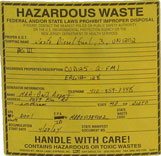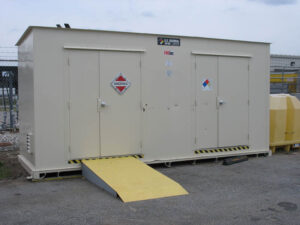 What is hazardous waste?
What is hazardous waste?
Hazardous waste is any substance with properties that make it dangerous or potentially harmful to human health or the environment if mismanaged. Hazardous wastes can be liquids, solids, contained gases, or sludges. They can be the by-products of manufacturing processes or simply discarded commercial products, like cleaning fluids or pesticides.
In Maryland, a material is regulated as a hazardous waste if it is specifically listed as such in State regulations, is mixed with or derived from one of those “listed” wastes, or exhibits certain characteristics defined in the regulations. MDE identifies these characteristics as ignitability, corrosivity (strong acids or caustics), reactivity (explosives or items which can release toxic gases when mixed with water), and toxicity (substances which will release certain levels of toxics when subjected to a test simulating conditions in a landfill).
Tenant activities may generate small quantities of waste that are classified as “hazardous” according to Federal and State regulations. These wastes result from routine equipment maintenance, vehicle maintenance, and painting. Hazardous wastes generated by tenants at BWI Marshall and Martin State Airports may include:
- Waste paint – it contains solvents which are flammable and toxic
- Used fluorescent lamps – they contain mercury vapor
- Used vehicle batteries – they contain lead and acid
- Mercury containing products such as auto and light switches, mercury thermometers, button batteries
- Fluorescent light ballasts – older ballasts may contain toxic polychlorinated biphenyls (PCBs)
- Absorbent materials used to clean up spills – they contain materials such as oil or gasoline
- Used solvents – they are toxic and flammable
- Corrosive liquids (acids and bases) – they can corrode containers and react violently with other materials
COMAR 26.13.03.02 identifies the requirements for determining if your material is a hazardous waste. Although a material may be a listed waste, this regulatory reference also identifies the procedure to demonstrate to MDE that the materials are not hazardous wastes given certain requirements are met.
COMAR uses the term “controlled hazardous substances” to be synonymous with “hazardous wastes” as used in RCRA regulations.
The USEPA has authorized Maryland to administer a state hazardous waste program that includes the federal Resource Conservation and Recovery Act (RCRA) rules and several more stringent requirements. In some cases, the federal regulations apply directly or are incorporated into the Maryland regulations by reference. The Maryland hazardous waste management regulations apply to hazardous waste generators; transporters; owners and operators of treatment, storage, and disposal facilities; handlers of universal wastes; and handlers of used oil.
Tenants that generate hazardous waste must arrange for shipment of their hazardous waste to a facility permitted to accept it. Additionally, the hauler must be certified by MDE and the waste must be accompanied by a document that tracks it from generation to disposal (the hazardous waste manifest).
The tenant must comply with regulations on the storage of the waste, and must follow specified procedures to prevent the occurrence of circumstances that would threaten human health or the environment. These requirements can be found through COMAR 26.13.
If your tenant organization produces hazardous wastes that must be handled and disposed of properly, there are a number of best management practices that may be implemented to assure this. These include:
- Developing Standard Operating Procedures for hazardous wastes. The procedures should include description of:
- Proper labeling procedures of each container of hazardous waste using a standard label.
- Waste storage procedures, including proper sorting and separation, proper storage conditions (temperature, ventilation, etc), and use of special storage sheds and secondary containment (as appropriate) prior to disposal.
- Storage inspection procedures to ensure that the wastes are being safely stored.
- Annual training for those employees handling hazardous waste describing how to manage the wastes.
- Schedules for periodic waste pickup from the storage sheds and record keeping (detailed records [manifests] must be kept on file for at least 3 years).
- Submission of reports to MDE identifying the hazardous wastes generated by the tenant.
- Additionally, managers and supervisors whose organizations deal with hazardous wastes should:
- Know which wastes your workplace generates are hazardous and how these wastes should be handled and stored,
- Make sure that personnel in your workplace who generate and handle hazardous wastes have received proper training.
- Look for ways to reduce the amount of hazardous wastes generated, for example, by substituting a non-hazardous material for a hazardous one.
- Employees who deal with hazardous wastes should be aware of how these wastes need to be handled, labeled, and stored.
- Contact your supervisor if you see any hazardous wastes that appear to be leaking or may not be stored safely.
MDOT MAA has developed several tenant directives that identify requirements associated with the identification and marking, storage, and disposal of hazardous wastes as well as procedures and reporting requirements should a spill of these materials occur. These tenant directives include:
Tenant Directive BWI-502.5 (Identification of the Fire Hazards of Stored Materials)
Tenant Directive BWI-502.4 (Drum/Container Markings, Storage, and Disposal)
Tenant Directive BWI-502.1 (Airport Fuel/Oil and Hazardous Material Spill Procedures and Legal Reporting Responsibilities)
One of the requirements of tenant leases is that tenants must adhere to the requirements of the applicable tenant directives and associated regulations. Not adhering to these requirements can impact the standing of the tenant lease.
Additionally, MDE administers enforcement actions for violations of state hazardous waste regulations. MDE may initiate civil actions or criminal prosecution that could result in fines of up to $250,000 and 15 years of imprisonment.
EPA has authority to take enforcement action for some provisions of RCRA, These actions can include administrative fines of $25,000 per day, as well as civil and criminal prosecution that could result in fines of up to $250,000 and 15 years of imprisonment.

